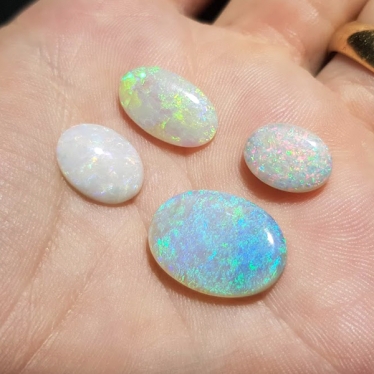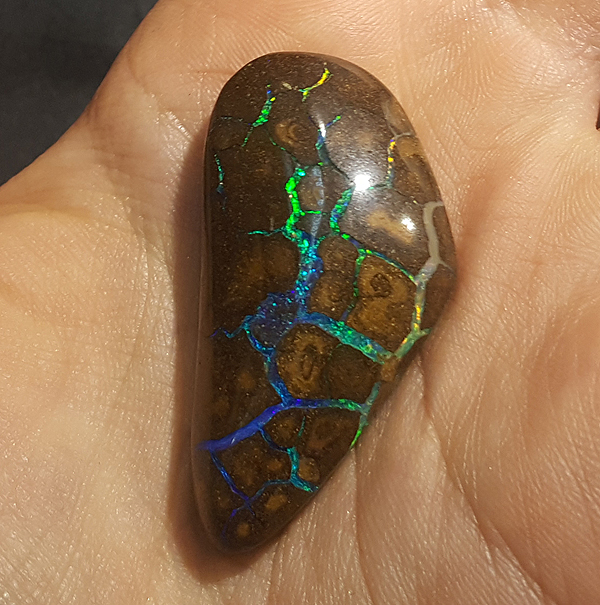Different Opal Types
Exploring Three Main Types of Natural Opal
There are three main solid opal types: classic solid, boulder opal, and matrix opal. Each of these types are 100% natural, meaning that they are not synthetic or enhanced in any way.
Type 1: Classic Solid Opal
A "classic solid" is the most traditionally sought after of all the opal types. In a classic solid opal, the whole stone is either entirely precious opal or a mixture of common opal (potch) and precious opal. There are four main body tones into which classic solid opals are divided: black, semi-black, light, and crystal.
Black Opal
 Black Opal Nobbie From Lightning Ridge
Black Opal Nobbie From Lightning RidgeA black opal is not a black stone. "Black" is referring to the body tone under the colour on the face of an opal. In a black opal, the body tone will range from dark grey to very black. The dark undertones in a black opal cause the stone's play-of-colour to appear brighter and more vivid. This is why black opals are usually considered the most valuable of the opal types - they have the "Wow Factor". The highest quality black opals usually come from Lightning Ridge, which is famously known as the "Black Opal Capital of the World."
Semi-Black Opal
 Semi-Black Opals
Semi-Black OpalsSemi-black opals are more commonly referred to as "dark opals". They are right in the middle of the spectrum between light opals and black opals. The body tone of a semi-black opal is grey. Typically, this will still cause the face of the opal to display bright play-of-colour.
Light Opal
 Light Opals
Light OpalsLight opals, which are most frequently mined in South Australia, have a light to white body tone. Light opals are known for showing incredible colour-play patterns and bright flashes of pink, red, orange, and green opal fire. Light opals usually look the best when displayed in low light.
Crystal Opal
 Crystal Opal
Crystal OpalA crystal opal is an opal stone with a high degree of transparency or translucency. Crystal opals can have any body tone, from light to black. Usually, the play-of-colour in a crystal opal will be bright because the transparency of the stone allows light to pass through it more easily. Scientifically speaking, a crystal opal is actually a type of crystal.
Type 2: Boulder Opal
One of our favourite opal types is the boulder opal. Boulder opal is a very unique type of opal stone that is found in the most remote outback areas of Queensland. Boulder opal occurs when silica solution enters empty voids in ironstone boulders, and then, over thousands of years, forms itself into the play-of-colour that opal is famous for. The unique way that the solution flows and seeps through the ironstone creates patterns that you will not find in any of the other opal types. An interesting fact about boulder opal is that in the old days, it used to be called "Barcoo Opal", nicknamed after a river that flows through the outback.
 Clean Faced Boulder Opal Specimen
Clean Faced Boulder Opal SpecimenWhen we cut the Queensland boulder opal, we leave it naturally attached to its host ironstone. This is one of the greatest things about boulder opal: it cannot be made synthetically. If you were to glue a seam of opal onto a slab of ironstone, the glue would eventually bubble and separate from the ironstone. When an opal is glued onto a dark backing, it is called a doublet. You can read about these "enhanced" opals here.
Yowah Nuts
 Yowah Nut Specimen
Yowah Nut SpecimenOne of the lesser known opal types are Yowah Nuts. Yowah Nuts are a subtype of Type 2 Boulder Opal, and are found only at the Yowah opal field in Queensland. They are small kernals of ironstone ranging from 5mm-200mm in diametre that contain at least one ring of precious opal in the centre. Yowah Nuts are an incredible feat of nature - it is still unsure how exactly they are formed. But regardless of the process, the results are astounding. Yowah Nuts contain some of the most breathtaking patterns and colours of any opal type.
Type 3: Matrix Opal
 Matrix Opal Specimen
Matrix Opal SpecimenMatrix opal is another form of boulder opal, also only found in Queensland opal fields. The main characteristic of matrix opal, which distinguishes it from all other opal types, is the veins of precious opal that run perpendicularly on the surface of the ironstone. Matrix opal formed when the silica gel that hardens into precious opal seeped into pockets and fissures on the face of a stone. The contrast of the bright, play-of-colour in the seams of precious opal with the deep brown of the host ironstone is what gives matrix opal is popularity and desirability.
To see more examples of all the opal types visit us on the Brisbane Opal Museum website.